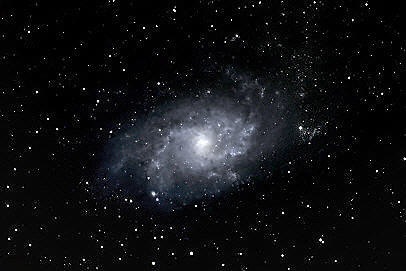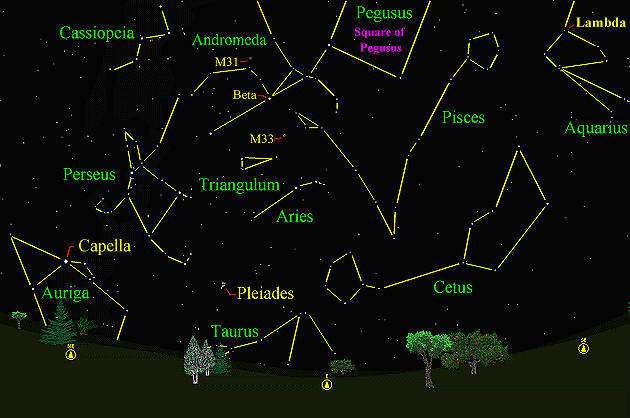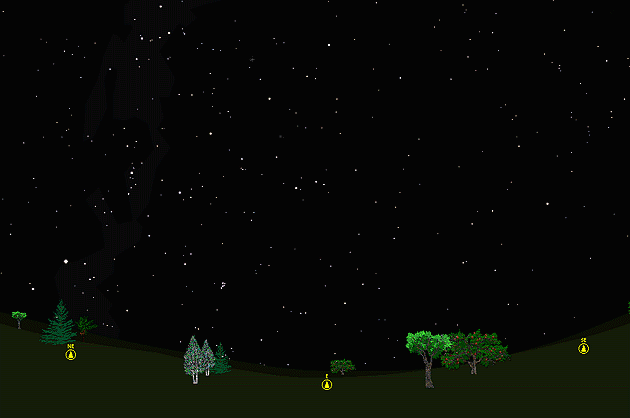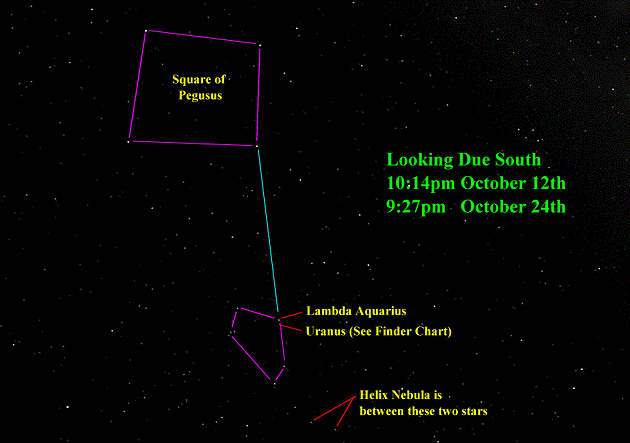The purpose of this feature is to give scout leaders, educators and naturalists an idea of some of the natural events coming up each month. We will try to cover a variety of natural events ranging from sky events to calling periods of amphibians, bird and mammal watching tips, prominent wildflowers and anything else that comes to mind. We will also note prominent constellations appearing over the eastern horizon at mid-evening each month for our area for those who would like to learn the constellations. If you have suggestions for other types of natural information you would like to see added to this calendar, let us know! Note: You can click on the hyperlinks to learn more about some of the featured items. To return to the Calendar, hit the "back" button on your browser, NOT the "back" button on the web page. All charts are available in a "printer friendly" mode, with black stars on a white background. Left clicking on each chart will take you to a printable black and white image.
Notes and Images From September 2006
The Triangulum Galaxy, M-33, is between 2 and 3 million light-years from our Milky Way Galaxy. Its face-on orientation gives it it another name, the Pinwheel Galaxy. On late September evenings it is well placed for viewing, although it is a bit more of a challenge to find than the brighter and nearer Andromeda Galaxy. Binoculars will usually show it as a small faint patch of light. I took this image on September 19th after a cold front had swept the sky clear. I started the computer program used to control the telescope imaging and went to bed, then arose a little after 3:00am to shut the scope down. I stepped outside to the clearest night sky I've seen in quite a while. The bright stars of Orion and Canis Major shone like diamonds in the eastern sky. M-33 was almost directly overhead, and with averted vision I could just make out it's glow with my naked eye, a new experience for me at our farm. Without trying too hard I could see 10 members of the Pleiades cluster. The chuckling calls of Southern Leopard Frogs drifted up from our pond, and a couple of Great Horned Owls called from across the railroad tracks. An Eastern Screech Owl trilled from a group of cedars not over 100 feet away, no doubt chiding me for trespassing. The cool hours before dawn brought a wonderful feeling of peace for me that morning, and I returned to bed feeling very fortunate.
Sky Events for October 2006: The Orionid Meteor Shower peaks in the morning hours of October 21st, with typical hourly rates of 10-15 meteors per hour in dark skies. Evening Sky: Jupiter continues to sink into the evening twilight glow this month. At midmonth, look for it about 10 degrees above the southwestern horizon at dusk. Mercury reaches greatest elongation from the sun on October 16th, but it will be quite low and hard to spot. Look for it around that date about 4 degrees below Jupiter. Jupiter will be much easier to see. Uranus is well placed for viewing with binoculars this month, near Lambda in Aquarius. See the notes and finder charts below. Morning Sky: Saturn rises about 2:00am at mid-month. All times noted in the Sky Events are for Franklin, Tennessee and are Central Daylight Time. These times should be pretty close anywhere in the mid-state area. Constellations: The views below show the sky looking east at 9:00pm CDT on October 15th. The first view shows the sky with the constellation outlined and names depicted. Star and planet names are in yellow. Constellation names are in green. The second view shows the same scene without labels. Prominent are Cassiopeia, Queen Cassiopeia, Andromeda, Princess Andromeda, Perseus, Triangulum, the Triangle, Aries, the Ram, and Cetus, the Sea Monster. Look above beta Andromedae and see if you can pick out the faint glow of the M31, The Andromeda Galaxy. City dwellers may need binoculars to pick it out. To get the best view, wait until the square is high overhead to look. If you find the Andromeda Galaxy, you might want to try to see M33, another nearby galaxy in Triangulum. Auriga, the Charioteer, with its bright star Capella, and Taurus, the Bull, are rising in the northeast. Look for the Pleiades, a beautiful open star cluster, not far above the eastern horizon. Also called the "Seven Sisters," this cluster has been known since antiquity. In Japan it is known as Subaru, and the Subaru automobile is named for this cluster. Note the position of Lambda in Aquarius in the chart below. The planet Uranus is near Lambda all month long and is an easy binocular object. See the finder charts below to locate it.
On Learning the Constellations: We advise learning a few constellations each month, and then following them through the seasons. Once you associate a particular constellation coming over the eastern horizon at a certain time of year, you may start thinking about it like an old friend, looking forward to its arrival each season. The stars in the evening scene above, for instance, will always be in the same place relative to the horizon at the same time and date each October. Of course, the planets do move slowly through the constellations, but with practice you will learn to identify them from their appearance. In particular, learn the brightest stars for they will guide you to the fainter stars. Once you can locate the more prominent constellations, you can "branch out" to other constellations around them. It may take you a little while to get a sense of scale, to translate what you see on the computer screen or what you see on the page of a book to what you see in the sky. Look for patterns, like the stars that make up Cassiopeia. The earth's rotation causes the constellations to
appear to move across the sky just as the sun and the moon appear to do.
If you go outside earlier than the time shown on the charts, the constellations
will be lower to the eastern horizon. If you observe later, they will
have climbed higher. As each season progresses, the earth's motion around the sun causes the constellations to appear a little farther towards the west each night for any given time of night. The westward motion of the constellations is equivalent to two hours per month. A good book to learn the constellations is H. A. Rey's
classic, The Stars, A New Way to See Them. Rey's depictions of the
constellations and witty commentary are terrific. A good general reference book on astronomy is the Peterson
Field Guide, A Field Guide to the Stars and Planets, by Pasachoff.
The book retails for around $14.00. A good beginners software program for learning the night sky is the Starry Night Beginner program. Visit the Starry Night web site at www.starrynight.com The program retails for around $30.00 and contains a wealth of information.
The 7th Planet From the Sun and a Halloween Ghost This month is a great time to spot the planet Uranus. The gas giant is easy to spot with binoculars, but you may want to first try the challenge of seeing it with your naked eye. To do so, it takes a clear, moonless night. First locate the the "Square of Pegasus". Now use the proportions of the square to locate Lambda Aquarius (see the chart immediately below). Then use the detailed finder chart to look for Uranus. For tips on spotting faint objects, go to Seeing in the Dark. You will have no moon to interfere when Uranus is due south between October 12th and October 24th. During that period Uranus will move very small amount westward. The close proximity of Lambda is both good and bad. It makes the planet's motion easy to see over a week or two, but Uranus is also a little harder to see with the naked eye next to the relatively bright star. There is another good moonless window for viewing the planet from around November 10th to November 22nd, and you can try again for the planet when it's a little farther away from Lambda. For naked eye views, if you cannot see the stars marked 54 and 58, you won't be able to see the planet. If you're successful in your quest, be sure to pronounce the name of the planet correctly when you announce your discovery - it's YOOR'-a-nus, with the accent on the first syllable, short "a" , short "u". While you're exploring this part of Aquarius, you may want to see if you can see the Helix Nebula with binoculars. Small and ghost-like, it's a fitting object for October. It too requires a very clear moonless night, and even then it's barely discernable. The Helix is a planetary nebula, and is around 650 light-years away. Planetary nebulae are shells of gas and plasma thrown off by stars near the end of their lives. The name "planetary" comes from the resemblance of small planetary nebulae to faint planets like Uranus and Neptune. They have been called, "the wreaths nature places around dying stars." If you are able to see the Helix, it will appear as a faint patch of light, featureless and colorless (our eyes are not good color receptors at low light levels). You may feel like the 19th century observer Lewis Swift when he attempted to see a very faint nebula discovered in Nashville by the visually-gifted Edward Emerson Barnard. Swift wrote Barnard that the nebula appeared, "about as near spiritual as anything conceivable here." However, if you're able to see the Helix, your eyes are detecting photons that were actually emitted from the nebula over 600 years ago. If you would like to see an absolutely smashing image of the Helix taken using both the Hubble Space Telescope and the wide view of the Mosaic Camera on the National Science Foundation's 0.9-meter telescope at Kitt Peak National Observatory, click Here. You can download the image at various resolutions. To find the Helix, start at Lambda Aquarius and move your binoculars from the purple-outlined 5-sided figure shown below to the two stars indicated. If you cannot see these stars with the naked eye, you will probably need a clearer night to spot the Helix Nebula with binoculars. Be sure and use averted vision. I'm not showing you where exactly it is between these two stars so you won't be biased as to its visibility.
Amphibians:
The frog and toad choruses continue to diminish in October, but some frogs and toads are still calling. Listen for Spring Peepers to call from patches of woods in the fall. On cool October nights, Southern Leopard Frogs call and breed as the cooler temperatures mirror their early spring breeding period. Southeastern Chorus Frogs sometimes give a very dry, raspy version of their call in October. You can locate many of the frogs and toads that have been calling more frequently earlier in the year by driving the back roads slowly on rainy nights. This is a two person job. One person watches the road for amphibians and one person looks out for other vehicles.
Birds: Fall migration continues. Try to get out and bird as often as you can. Recommended: Bird Finding in Tennessee, Michael Lee Bierly. A classic guide to finding birds in Tennessee. The Sibley Guide to Birds, David Allen Sibley The Sibley Guide to Birds of Eastern North America, David Allen Sibley A Field Guide to the Birds of Eastern and Central North America, 5th edition. 2002. Roger Tory Peterson and Virginia Marie Peterson. If it's been a while since you've picked up a Peterson bird guide, you may be pleasantly surprised by the large image scale of the drawings. Just the thing for those fall warblers! An inexpensive guide for beginners is the Golden Guide for Birds.
Archives (Remember to use the back button on your browser, NOT the back button on the web page!) Natural Calendar September 2006 Natural Calendar February 2006
Natural Calendar
December 2005
Natural Calendar
November 2005
Natural Calendar
September 2005
Natural Calendar
February 2005
Natural Calendar
December 2004
Natural Calendar
November 2004
Natural Calendar
September 2004
Natural Calendar
February 2004
Natural Calendar
December 2003
Natural Calendar
November 2003
Natural Calendar
September 2003 Natural Calendar February 2003 Natural Calendar December 2002 Natural Calendar November 2002 Nature Notes Archives: Nature Notes was a page we published in 2001 and 2002 containing our observations about everything from the northern lights display of November 2001 to frog and salamander egg masses. Night scenes prepared with Starry Night Pro software All images and recordings © 2006 Leaps
|





